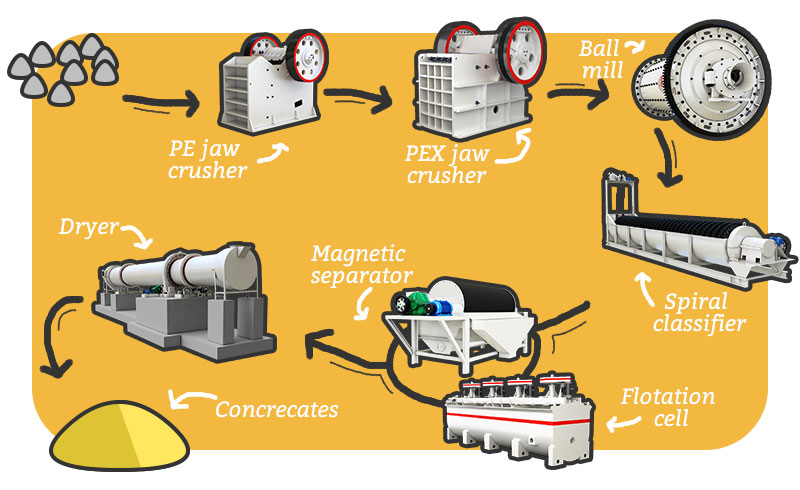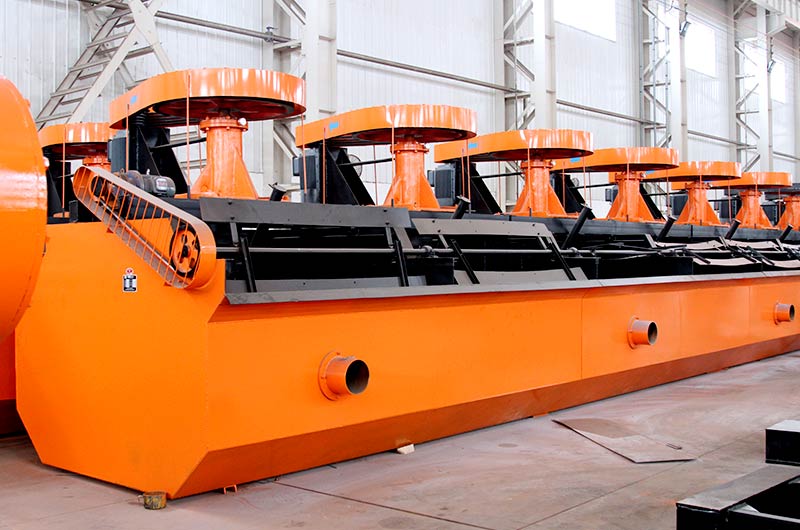
Gold has been throughout recorded history a precious metal and a relatively rare element that boasts considerable commercial prospects and potential for upward revaluation. The consumption of gold produced in the world is about 50% in jewelry, 40% in investments, and 10% in industry. Only after gold extraction that requires a combination of comminution, mineral processing, metallurgical processes can enable the final recovery of gold concentrate or gold ore with high grade of gold. The processing techniques in the beneficiation stage can include grinding, screening, milling, classification, separation and dehydration, etc. , applying methods mainly like froth flotation, magnetic separation, gravity separation, cyanide-in-leach (CIL), cyanide-in-pulp (CIP), carbon elution, carbon activation. Generally speaking, the gold ore shall be fed into jaw crusher for the first stage of crushing, and can be broken further if necessary(usually for processing hard rock or high crushing ratio). After secondary or tertiary crushing the material we process are reduced into very fine particle size, and then through the vibration feeder, the gold ore are evenly and continuously conveyed into the ball mill. The milled material enters the flotation machine for flotation separation,with flotation agent added to stir as the essential stage of the entire production line. After that, the material is entered into the concentrator for concentration, and then dried by a dryer to finally extract and obtain the required gold ore product.

In the following is a break-down of the plants and methods required in the process of gold recovery and refining.
Froth Flotation Separation Process
Flotation method uses flotation agents to treat minerals attached to bubbles according to different physical and chemical properties of mineral surfaces. Non-ferrous metal ores such as copper, lead, zinc, sulfur, and molybdenum can use the flotation method to process. Some ferrous metals, rare metals and some non-metallic ores, such as graphite ore, apatite, etc. are also selected by flotation.
Flotation is one of the most widely used methods for treating vein gold ores in gold concentrators. In most cases, flotation is the most effective method to treat gold-bearing sulfide minerals with high floatability; it is usually applied when the gold present in an ore is closely associated with sulfide minerals such as pyrite, chalcopyrite or arsenopyrite, and when such sulfides are present in large quantities in the ore. In this case, concentration of the sulfides results in concentration of gold values. In addition to necessary equipment as mentioned above, the flotation line also requires particular plants like agitating tank, flotation tank, foam tank, rotary dryer, which are all available by our companies in numerous models.

Magnetic Separation Process
Magnetic separation method is based on the different magnetic properties of minerals. Different minerals are subjected to different forces in the magnetic field of the magnetic separator. Nonferrous and rare metal ores such as iron, manganese and chromium can be separated from minerals by magnetic separation.
The magnetic separation process requires magnetic separator and dryers in addition.

Gold Leaching Process
Gold extraction by cyanide method is the main method for extracting gold from ores or concentrates.
In some cases, particularly when the gold is present in the ore as fine particles or is not sufficiently liberated from the host rock, the concentrates are treated with cyanide salts, a process known as cyanidation leaching, followed by recovery from the leach solution.
It usually includes cyanide-in-leach (CIL) and cyanide-in-pulp (CIP).
HXJQ offers necessary equipment in the gold beneficiation process featuring compact structure, high degree of automation, low failure rate and energy-saving and environmental qualities. Welcome to consult.

Please fill in the form below or inquiry online to get price & service
 Chat Online
Chat Online
 Get Quote
Get Quote